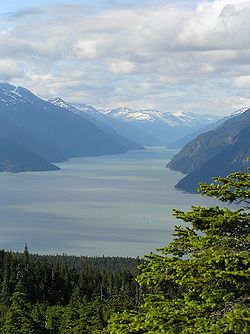
Taiya Inlet
Encyclopedia

Lynn Canal
Lynn Canal is an inlet into the mainland of southeast Alaska.Lynn Canal runs about from the inlets of the Chilkat River south to Chatham Strait and Stephens Passage...
located in the U.S. state
U.S. state
A U.S. state is any one of the 50 federated states of the United States of America that share sovereignty with the federal government. Because of this shared sovereignty, an American is a citizen both of the federal entity and of his or her state of domicile. Four states use the official title of...
of Alaska
Alaska
Alaska is the largest state in the United States by area. It is situated in the northwest extremity of the North American continent, with Canada to the east, the Arctic Ocean to the north, and the Pacific Ocean to the west and south, with Russia further west across the Bering Strait...
. The Taiya Inlet is an estuary
Estuary
An estuary is a partly enclosed coastal body of water with one or more rivers or streams flowing into it, and with a free connection to the open sea....
which lies in a deep valley, with Skagway, Alaska
Skagway, Alaska
Skagway is a first-class borough in Alaska, on the Alaska Panhandle. It was formerly a city first incorporated in 1900 that was re-incorporated as a borough on June 25, 2007. As of the 2000 census, the population of the city was 862...
at its north end and the remainder of the Lynn Canal at its south end.
History
The Taiya Inlet received its name in 1868. Taiya was derived from the TlingitTlingit language
The Tlingit language ) is spoken by the Tlingit people of Southeast Alaska and Western Canada. It is a branch of the Na-Dené language family. Tlingit is very endangered, with fewer than 140 native speakers still living, all of whom are bilingual or near-bilingual in English...
term tayee, which means beneath or underneath. It was also called Dayday Inlet and Dejah Inlet but the latter two names fell out of favor. The Taiya Inlet was an important waterway during the Klondike Gold Rush
Klondike Gold Rush
The Klondike Gold Rush, also called the Yukon Gold Rush, the Alaska Gold Rush and the Last Great Gold Rush, was an attempt by an estimated 100,000 people to travel to the Klondike region the Yukon in north-western Canada between 1897 and 1899 in the hope of successfully prospecting for gold...
offering passage to the deep-water port of Skagway and, by smaller boat (due to sediment from the Taiya River
Taiya River
The Taiya River is a 17-mile-long river in the U.S. state of Alaska running from the border with British Columbia, Canada, to the Taiya Inlet of upper Lynn Canal.-Geography:...
), the now-ghost town
Ghost town
A ghost town is an abandoned town or city. A town often becomes a ghost town because the economic activity that supported it has failed, or due to natural or human-caused disasters such as floods, government actions, uncontrolled lawlessness, war, or nuclear disasters...
of Dyea
Dyea, Alaska
Dyea is a former town in the U.S. state of Alaska. A few people live on individual small homesteads in the valley; however, it is largely abandoned. It is located at the convergence of the Taiya River and Taiya Inlet on the south side of the Chilkoot Pass within the limits of the Municipality of...
. These two boom towns were gateways to the respective White Pass
White Pass
White Pass is a mountain pass through the Boundary Ranges of the Coast Mountains on the border of the U.S. state of Alaska and the province of British Columbia, Canada...
and Chilkoot
Chilkoot Trail
The Chilkoot Trail is a 33 miles trail through the Coast Mountains that leads from Dyea, Alaska in the United States, to Bennett, British Columbia in Canada....
trails.
Taiya Inlet Winds
The winds in the Taiya Inlet are frequently diverted from their true courses by the mountains surrounding the valley in which the inlet lies. These diverted winds in the Taiya Inlet are also frequently more turbulent than the winds over the remainder of the Lynn Canal.The Tlingits believed that the turbulent winds in the Taiya Inlet were under the control of an ill-tempered spirit known as “Kanuga.” The spirit “Kanuga” is supposedly embodied as a “rock” near the north end of the Taiya Inlet. (This “rock” is apparently Face Mountain, and the spirit is now apparently called “Kanagoo.”)
Generally, the Tlingits had separate names for winds that are diverted from their true courses by mountains and valleys (as the Taiya Inlet winds are). The name Skagway is derived from the Tlingit term shgagwèi, which refers to these turbulent winds in the Taiya inlet, and to the rough seas in the inlet created by these winds.
Current status
Currently the Taiya Inlet is used for marine transporatation (such as the Alaska Marine HighwayAlaska Marine Highway
The Alaska Marine Highway or the Alaska Marine Highway System is a ferry service operated by the government of the U.S. state of Alaska. It has its headquarters in Ketchikan, Alaska....
) and recreation such as fishing. The Taiya Inlet Watershed Council is also dedicating to its preservation.

